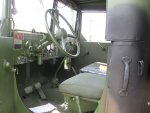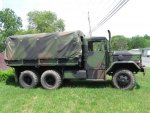If there are any pros and/or cons to this particular model I wish someone would shout out as I'm new to these vehicles and would hate to drive that distance only to find out there's some obvious question or deal breaker I overlooked, otherwise WISH ME LUCK!!!
Congrats, first off. You are travelling on a Sunday, so quickly popping into a truck garage or NAPA for a part you need to keep on rolling could be an issue (think of your plan for that). I second the suggestion to take some time, check the members' map and see who would be close enough to lend a hand and/or tow you and figure out how to contact them. Personally, I would probably carry a few of the maintenance items you will have to have on hand anyways, owning this truck (bulbs, belts, hose clamps, lug nut socket (it is ok if you do not want to change a tire, but you do need to be able to tighten a loose lug nut) and breaker bar. Hand tools (socket set etc.). Ask the owner which brake fluid is in the truck (3 or 5?) and carry at least a small bottle of it.
350 miles is not extremely far, but it is long enough of a trip to become stressful really fast, should things go wrong. "A deal breaker you overlooked" would likely be very obvious after this trip. Other than that...you have a 45 year old truck...it's out of warranty!

There are several threads about how to prepare for a lengthy first-time thread. Most of it is common sense. Some of it is having at least heard of some of the things that can go wrong and know what to do, if... (think broken throttle return spring, overheating hubs, clogging filters etc.)
I suggest to do a methodical pre-trip inspection. Have a printed copy of the operator's manual with you!
My emphasis would be that you know how to check the fill level of the master cylinder (I, personally, would be checking the brake fluid level a couple of times during the trip on a truck new to me; there is no "low brake fluid" warning lamp). Also check lug nuts (they have right and left hand threads!) with a nut and breaker bar and ensure they are tight. Check underneath, armed with a rag and 1/2 in drive ratchet for any visible leaks (I would probably check the oil level in the tranny and transfer case...hence the rag and ratchet). Seeing how you are down there already, check the nuts that hold the U-joints of the short jack shaft between tranny and transfer case (they like to come loose). Check the drive shafts for play on both ends where they enter the axles and the tranny/transfer case. Looseness and signs of oil spills are not good before a long trip.
Check the batteries (tied down? Terminals securely fastened? Remember, you don't have a main power switch that you can shut off if something starts throwing sparks...).
On an unpaved road surface, do a lock-up brake check...go about 20mph and do a panic stop. Full on the brakes, hard, all the way. IF there is an iffy brake hose, NOW is the time to blow it, not during the trip. Does the truck drift off to one side before coming to a stop? A good time to check the parking brake before you hop out of the cab.
Check for skid marks behind each wheel...you want to see that they all locked up, and braked fairly equally (same length of skid mark between similar wheels on each side). If there is no skid mark at any one wheel, rinse and repeat...if still no skid mark, you could have a wheel without brakes. If all works, you can have the confidence of already having experienced how the truck stops!
Sorry if any of this sounds paranoid. I rather spend a bit more time up-front checking things before I get going, than on the edge of my seat during the drive, hoping that it will all work out.






